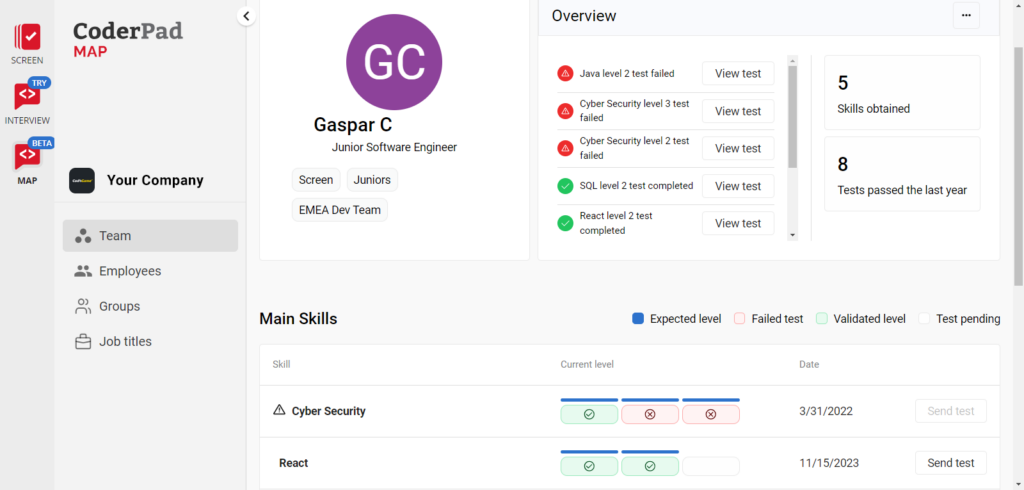Bridge Skill Gaps and Hire The Devs Your Team Needs with an Engineering Competency Matrix
Addressing skill gaps is crucial for team productivity and project success.
In CoderPad’s 2024 State of Tech Hiring Survey, a key issue highlighted by almost 27% of the developers was their team’s lack of technical knowledge for implementing projects.
This challenge often stems from non-existent or outdated skills tracking systems. Understanding and mapping your employees’ technical skills is essential not just for forming efficient teams but also for enhancing overall productivity by complementing skill sets.
So, how can you effectively identify and leverage the diverse skills within your workforce when assembling teams and designing career progression plans?
The answer lies in the Engineering Competency Matrix (ECM).
This tool helps in accurately gauging and utilizing the technical abilities of your developers, ensuring that every project is matched with the right expertise.
What is an ECM?
At its simplest, an ECM is a table that displays a particular employee’s skill and skill levels.

Skills
The skill can be any competency you want to measure or test for, whether cybersecurity knowledge, building apps with React, or database design fundamentals.
Generally, you’ll want to ensure you’re covering skill sets to cover a particular job role. For example, a full-stack developer might need to be competent in Angular, Node.js, and Postgres, while your DevOps engineer may need Azure, AWS, and Docker knowledge.
The decision as to what skills to track should be a collaboration between engineering managers, human resources, technical recruiting, and project managers to ensure that the needs of stakeholders are met for both identifying skills gaps for projects and creating training plans for individual employees.
Skill level
Generally, most skills are divided into junior/beginner, intermediate, and senior/expert levels. What you’ll need for a specific project will again depend on meeting with the stakeholders to determine the required technical skills.
Often, you’ll want to review skills to ensure you have a good mentor for more junior project or team members; having an ECM can help facilitate that by identifying the senior or expert members who can pass along their skills and experience.
Team members
Your employees should be listed somewhere inside the matrix so you can quickly identify their skill level.
The hardest part in organizing or creating an ECM is figuring out how to measure the skills of your employees. Self-assessments can be misleading, and you’re surely not going to pull out resumes from seven years ago and spend hours plugging them into a spreadsheet.
CoderPad Map makes the ECM process easier by allowing you to send out user-friendly assessments to your team members and then generate the ECM for you based on their assessment results.
✅ AG5 offers a great list of free skills matrix templates you can use or to get an idea of what your ECM might look like.
How to use your ECM
As we’ve alluded to earlier, two of the most prominent use cases for an ECM are identifying skill gaps for training and putting together teams with complementing and necessary skill sets.
Put appropriate teams together
One of the biggest challenges of putting together a team for any project is 1) identifying the skills needed for the project’s success and 2) identifying who has those skills.
An ECM will help you identify who does and does not have the skills you’re looking for. Once you can identify the skills gap that’s preventing you from creating the super-team of your dreams, you can act on that in a few ways:
- Move someone internally who has those skills onto the project team.
- Find someone on the team who does not yet have the skill but has an aptitude for a similar skill and train them on it.
- Find someone currently on the team who does not yet have the skill but wants to learn it and train them on it.
- Start the external hiring process to grab someone from outside the company to add them to the team.
- Alternatively, you can look at existing teams with experience working with each other, have most of the skills you’re looking for, and train them as needed.
✅ Hackathons are another way to discover hidden talent in your organization.
A good ECM should be easy to update and up-to-date, which means you should be assessing your candidates regularly, at least annually. There’s nothing worse than bringing someone on who has not used a skill you need in a very long time or missing out on a great team member with a skill because they’ve never been assessed for it.
Identify skills gaps for training
The other big reason to use an ECM is to help employees get a sense of their strengths and weaknesses so you can help them improve their own career outlooks; helping your employees grow their expertise shows a commitment to caring about employees’ professional development.
A good ECM will allow you to track a developer’s progression, showing you both what skills they struggle with and what ones they take to quickly. That will help open up potential career tracks they may have never considered or help them avoid ones they may not be a good fit for.
Additionally, using a before-and-after assessment method with your ECM will help you assess the added value of the training programs you use to upskill your employees. These programs are often expensive, and you’ll want a more effective metric than “Did they show up for the class?”
Conclusion
An effective ECM will make a drastic difference in your project management processes and help retain employees by displaying loyalty to their career growth.
If you’d rather not dedicate the time to manually collecting employees’ skill sets and levels and creating your own convoluted ECM, you can use CoderPad Map instead.
CoderPad Map lets you quickly send pre-made technical skill assessments to your employees and automatically generates an ECM based on their results and job roles.
